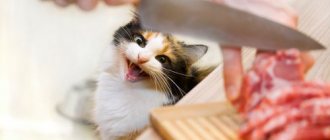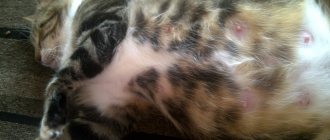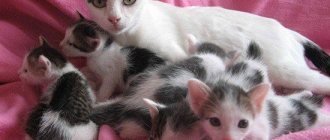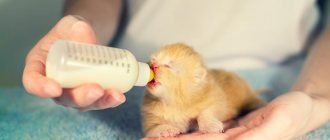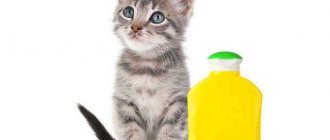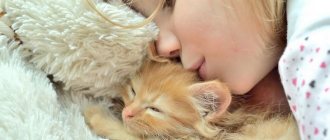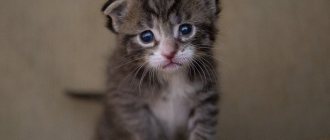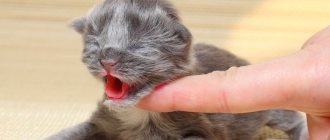When a cat has given birth, the owner should know at what age it is possible to wean and give away offspring without causing harm to the babies and mother. The future owner needs to become familiar with the characteristics of newborn kittens and know the optimal weaning time. In order for the pet to grow up healthy, the owner needs to provide care for the kitten and take care of feeding.
According to breeders, it is recommended that a purebred baby be taken away and given away at the age of 3-4 months, since by this time signs of the breed appear and the baby's hair falls out.
Features of newborn kittens
Immediately after birth, the cat releases the babies from the amniotic sac, which allows the kitten to take its first breath. The babies are wet at this time, the mother licks them and later pushes them towards the nipples. Main features of babies:
- Dream. During the first and second weeks, kittens eat and sleep most of their lives. During sleep, the baby may shudder, move his paws, and smack his lips. This indicates the active phase of sleep and is normal. For the first 2 days, cats sleep with their heads tilted towards their chest.
- Weight. Normal full-fledged babies weigh 70-130 g, gradually gaining weight.
- Vision and hearing. Kittens are born blind with closed eyes, which should open in 1-2 weeks. During this period, the cubs begin to hear.
- Touch and smell. Developed because the kitten smells milk, so it approaches the cat’s belly and grabs the nipple.
- Sucking reflex. Very developed. If a kitten is taken away early, the instinct remains for a long time, even when the baby grows into an adult cat and sucks the owner's hand.
- Defecation. The kitten does not yet know how to go to the toilet on its own, so the cat must stimulate the tummy by licking it in the genital area. At 1 month, the baby can already go to the tray on his own, which his mother teaches him to use.
- Leather and wool. Always clean and well-groomed, the skin is light pink and elastic.
- Behavior. The older the kitten gets, the more intensely it moves and shows curiosity, getting out of the box or basket. Therefore, inactive babies may be sick, and in a Scotsman or Briton this indicates osteochondrodysplasia.
Are there exceptions to this rule?
Yes. The exception is feral kittens . These are the kittens that were born to a street cat and have never had any contact with people. In this case, the need to learn to live with people outweighs their need to communicate with their mother and siblings. If they stay with their mother for too long, they will only learn to fear people. If you are caring for a prodigal cat and her kittens, it is best to take the kittens home at 8 weeks . At this age, they can feed on their own, but are young enough to overcome their fear of people and successfully socialize. Some experts even suggest 6-8 weeks as a suitable time frame, depending on your specific situation and whether you can have both mother and kittens in your home at the same time.
When can you separate a kitten from a cat?
Kittens can be given away no earlier than two months after birth, and the new owners need to pay maximum attention to the babies.
Scottish Folds can be adopted after their ears drop, but not earlier than 2 months. Separating a one-month-old baby from its mother is not recommended, since it is stressful for the offspring and the cat, leads to psychological illnesses and even ends in death. The optimal age for giving away kittens is from 12 weeks. Being deprived of maternal care at 7 weeks, the babies still need their mother, which means that the owners will have to pay maximum attention to the new residents. If a cat abandons the kittens, does not respond to them and does not feed them, the cubs are taken away and transferred to artificial nutrition. In this case, you can give the kitten away immediately, provided that the owner devotes himself entirely to care and feeding.
How to prepare kittens for separation from their mother
Mother's milk is important for a pet. Kittens receive nutrients and antibodies to strengthen their immunity. There is no need to prepare animals for separation. To understand how many months kittens are given away, keep in mind that at the age of 7-8 weeks they no longer need milk as the only source of nutrition.
The cat itself drives away annoying individuals from the nipples, although out of habit the pets can fall on them for up to 5-6 months. If the animal continues to lactate, it is recommended to allow the young to suck the milk once a day. The transition to adult food can be made easier by adding low-fat cottage cheese and natural sourdough yogurt to the menu. After weaning, kittens are given special canned meat, boiled chicken, and beef.
How to give away your baby correctly?
A nursing cat has a very developed instinct for preserving offspring, so tearing all the kittens away from her at once is cruel and dangerous to health. It is better if the future owner comes to the house, sometimes picks up the baby and returns it to the mother. So, she will understand that the person does not take away the cub. The kitten also needs to get used to new smells and sensations. Therefore, babies need to be selected gradually in this way:
- They give clothes or an item from the new owner so that the kitten gets used to the foreign smell.
- The future owner should visit the baby regularly so that he gets used to the smell and touch.
- You can take the cat away from its mother for 2-3 hours so that new family members can interact with the pet.
- You should not select offspring if the cat is against it, does not give up the cubs, hisses and growls. It's better to wait a little and try again in a few days.
- When a kitten is given away to a new family for good, it is advisable to take bedding from the old room so that the baby is comfortable and has the smell of his mother nearby.
- When the last kitten is given away, everything that smells of the cubs and reminds of them is gradually taken away from the cat.
Oh no I got my kitten when he was only 4 weeks old
Sometimes kittens are adopted by a family at a very young age. Rescued kittens may even be newborns, separated from their mother for unknown reasons. In other cases, irresponsible cat owners who allow the cat to breed may be unaware of proper kitten care and separate them from their mother too early.
If you already have a kitten at such a young age, all you can do is learn about kitten care and try to provide your pet with the appropriate environment and care that it needs.
From the first day of birth, the basis of a kitten’s life is mother’s milk. Until they are three weeks old, kittens' immune systems are unable to produce antibodies (immunoglobulins) that can protect them from infections. But one day, any baby has to grow up and switch to “adult” food. When can a kitten be separated from its mother so as not to cause harm to its health?
The meaning of mother's milk
Milk helps kittens resist pathogens in the youngest period of life - it is very rich in antibodies (provided that the mother cat was vaccinated no more than a year before mating). Thus, mother's milk strengthens the kitten's immunity.
In the first weeks, kittens should have an exclusively dairy diet. On average, a cat feeds its babies 12 times per day. The recommended period of breastfeeding is from one to three months. The completeness of a kitten’s immunity largely depends on how long it has been fed its mother’s milk.
Cat milk replacers
Although the best food for kittens is mother's milk, life sometimes has its own way, and it is not always possible to plan when to tear a kitten away from its mother. It is good if it is possible to place a kitten on another cat that has recently given birth. But the likelihood of this is low, since quickly finding a nursing cat is very difficult. Therefore, the optimal solution in such a situation is a cat milk substitute.
Milk from different animals is approximately the same in composition, but the ratio of components is different. Any milk consists of more than 70% water. But the levels of fat content, proteins and lactose in cat milk are much higher than those of a cow or, for example, a goat.
The fat content of cat's milk is about 11%, while cow's or goat's milk is only about 4%. The protein content is also at least 11%, in the milk of cows and goats – 4%. Lactose content in cat milk is lower and amounts to 3%, while in cow and goat milk this figure is 6%.
All this suggests that milk from other animals is not suitable for feeding kittens. And here a cat’s milk substitute comes to the rescue, the ratio of components in which is carefully verified and as close as possible to real milk.
In addition to fats, proteins and lactose, it contains substances necessary for the normal development of the baby: minerals, vitamins and trace elements. The substitute contains taurine, an amino acid that is very important for the health of cats, as well as Omega-6 and Omega-3 fatty acids. The lack of these substances for a kitten’s rapidly growing body threatens the development of various pathologies.
You will learn how and in what proportions to dilute the dry substitute mixture from the preparation instructions on the package.
At what age are kittens weaned from their mother?
You definitely shouldn’t separate your baby from his mother until he is 1.5-2 months old. After all, it is by this age that the mother cat will teach the kitten to eat on its own, wash itself properly and go to the toilet.
Like people, in cats the behavior of babies directly depends on the level of “culture” of the parents, primarily the mother cat. It is she who is responsible for the socialization of the kitten in the first stages of its development
And this is extremely important, because it is at this time that the kitten’s character and behavioral model are formed.
When kittens are separated from their mother too early, they can grow up to be aggressive, distrustful and overly impulsive. Often, having not received the necessary “lessons” from their mother, they reluctantly accept the love of their owners and avoid playing with them. In a word, they grow up uncommunicative and withdrawn. Only your love, affection and patience can change this state of affairs.
To ensure that the new inhabitant of your home grows up mentally balanced and physically healthy, find out how and when you can take a kitten from its mother and get recommendations on how to
Proper kitten care
When purchasing a pet, you should take care of all accessories, including a tray, which must match the size of the animal.
In order for the cat to quickly adapt, it would be correct to purchase the following contents in advance:
- Tray. If the baby is less than 5 weeks old, you need a basin with low sides. It is better to choose a regular plastic tray; closed toilets are not suitable for babies. Wood or corn filler is suitable. Silica gel primer contains chemical impurities, so it is not suitable for children.
- Scratching post. When your baby first appears indoors, you should show him where he will sharpen his claws. You need to train it from the first days, otherwise the kitten will damage the furniture. You can make a scratching post yourself from a piece of an old rug and hang it on the wall, decorating it with movable soft pet toys.
- A bowl. You will need 3 of them - for dry and wet food, water. It is better to choose ceramic or plastic. Metallic ones can oxidize food and water.
- Sun lounger. It is better to place month-old babies in a box with woolen fabric on the bed. For older cats, a bed with low sides is suitable. Some cats choose their own resting place, so if it is safe there, you can leave it there.
- Ear and eye hygiene. Particular attention should be paid to the ears of a Scottish cat, since due to the special structure of the ears, dirt accumulates inside and bacteria develop. The baby’s hearing and vision organs are wiped with special animal products “Beafar”, “Trixie”, “Diamond Eyes”.
- Grooming. For delicate fur, a wooden comb with frequent short teeth is suitable. When an animal sheds hair, combs are purchased based on the length and thickness of the fur and undercoat.
The baby is very curious and climbs everywhere, so it is advisable to put protective plugs on the sockets and put the wires out of sight, since the kitten can touch it with its claw and get an electric shock.
Kittens under two months of age
There is no need to rush to take home a baby at the age of 1-2 months. This is not the best time to part with your cat. In the period up to 2 months, kittens acquire important skills. A well-mannered mother teaches her kids:
- use a scratching post rather than upholstered furniture;
- go to the litter box;
- use claws and teeth for their intended purpose;
- eat complementary foods;
- Follow cat hygiene rules.
It may seem that the owners can teach all this. But experts rightfully claim that cats are much better at this upbringing. The kitten learns all these rules without stress and learns them better.
There are also anatomical features that prevent kittens from being weaned at the age of 2 months. At this time, babies are vaccinated to build immunity. But the protective system does not strengthen immediately. This requires 2-3 weeks. The process is faster and better if the kitten is with its mother and receives an additional supply of antibodies with her milk.
How and what to feed your baby?
When the kitten is six weeks old, they begin to feed it seven times a day, with special dry food.
Before distributing the cubs to other people, the breeder must tell them how the cubs ate, since a sudden change from one food to another causes dyspepsia in kittens. At 6 weeks the animal is switched to dry kitten food. The number of feedings is 7 times a day and as they grow older, one feeding is eliminated every month. If the cat is purebred, a large selection is offered by Royal Canin, which produces food for Maine Coon, Persian, Siamese, and British babies. Or they are fed with special high-quality food with o, “Pronature”, “Origin”, “Akana”, “No”, “Go”, “Karnilov”, “Nutram”.
A small pet's diet should include boiled boneless fish and liver (no more than 1 meal every 2 weeks), raw frozen meat, cut into small pieces. Steamed meat products are strictly not recommended. Minced meat is undesirable because the baby will not learn to chew. Gluten-free porridges are healthy - rice, buckwheat, oats with the addition of meat ingredients and boiled vegetables. Raw yolk and low-fat cottage cheese can be 1 r. in 7 days. All products should be introduced gradually, in small portions, observing the body's reaction. After a year, an adult cat is given food with the Adult symbol if there are no health problems.
Negative consequences of premature separation of a kitten from its mother
If kittens are taken away from the cat immediately after birth and not allowed to feed on their mother’s milk, then they will not receive the necessary antibodies and strong immunity. This will lead to frequent illnesses that can be severe.
The kitten's digestive system may be disrupted. Kittens that have not eaten much of their mother's milk have difficulty digesting adult food; their enzymes have not yet matured. As a result, diarrhea or dysbacteriosis may begin.
A kitten deprived of its mother's training will take longer to get used to the tray and use of a scratching post. Kittens weaned early do not know how to calculate the force of their bite during play, or how to retract their claws. Such babies experience severe stress in the absence of their mother and their brothers and sisters. All this can greatly affect the psyche of an adult cat, causing nervous disorders.
Different prices for kittens: main reasons
Pet class kittens are the cheapest. The higher the category, the higher the price tag will be. The first thing included in the price is the breeder's expenses. He needs a good pair that will produce healthy offspring, the cost of which is at least 120 thousand rubles.
Next, you need to feed the kittens, provide them with proper care, prepare documents for the pedigree, and get vaccinations. You need to recoup the costs within 3-5 years, because this is the maximum period during which it is recommended to obtain offspring from a cat. It is also prohibited to allow more than 2-3 litters per year, because the animal’s body must recover after childbirth and lactation.
The price is also influenced by the nursery's reputation, class, and pedigree. People line up for popular breeders, and he can decide what price to set. The cost is often influenced by the rarity of the color or the structural features of certain parts of the body. For example, a fold-eared kitten costs more than a straight-eared one.
The optimal age for a kitten to be weaned from its mother, why you can’t take the baby earlier
Not all cat lovers pay attention to the age at which a kitten is separated from its mother. However, this factor deserves attention. Many people believe that it is better to pick up the baby early in order to promptly accustom him to cat litter, the food that he will constantly eat. But these are misconceptions. There is an optimal age for weaning a kitten from a cat, which ensures smooth adaptation and reduces the risk of various problems. It is worth studying the features of the development and upbringing of children in different periods in order to make the right decision.
